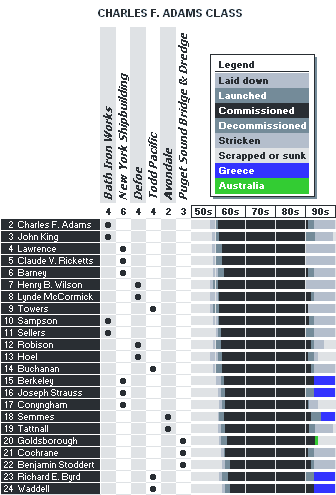

Although Congress authorized the first eight ships as all-gun destroyers, they were designed to provide anti-air missile defense for aircraft carriers. Their initial armament carried over that of the Forrest Shermans with a twin-arm (Mark 11) or “one arm bandit” (Mark 13) Tartar missile launcher replacing the earlier class’ after 5-inch gun. Overall length was increased by nearly 20 feet over the Forrest Shermans to accommodate a Mark 16 ASROC launcher between the stacks.
The US Navy commissioned 23 Adams in 1960–64. Australia and West Germany also purchased three ships each, with modified armament. Shipmates were proud of their appearance, with their sleek hulls complemented by harmonious upperworks. Despite their low freeboard aft, they proved to be excellent sea boats thanks to their high bows.
The Adams served successfully for three decades, contemporaneous with the Farragut-class DLGs. Over the years, their radar and fire control systems were upgraded from the SPS-37 radar fitted in the first 13 ships to the SPS-40; their original Tartar missiles were replaced with Standard missiles, and when fitted with the SPG-60 and SPG-51D tracker-illuminators, Adams-class destroyers could track three missiles simultaneously.
Later in their careers, as advances in anti-submarine warfare required destroyers to embark helicopters, new construction such as the Spruance class incorporated helicopter landing platforms. As the Adams’ large superstructure precluded such a modification, they often operated with Knox-class escorts or other helicopter-carrying ships. The 1,200 psi geared steam turbine propulsion machinery, too, proved troublesome and suffered especially in comparison with the Spruances’ gas turbines: with welded fittings, they could not be repaired while a ship was under power.
In 1889, therefore, in light of the imminent commissioning of the advanced Arleigh Burke-class DDGs, the Navy decided not to undertake further modifications. Between October of that year and the end of 1991, it decommissioned twenty Adams. The last one, Goldsborough, lingered until April 1993, after the second Arleigh Burke was delivered and construction hit stride.
Today, Charles F. Adams is the only survivor, laid up at Philadelphia awaiting disposition—fondly hoped by the more than 35,000 Adams-class veterans to become the centerpiece of a new Adams Class Naval Museum in Jacksonville, Florida.